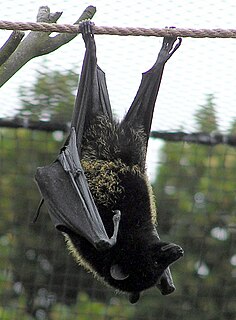
Livingstone's fruit bat, also called the Comoro flying fox, is a megabat in the genus Pteropus. It is an Old World fruit bat found only in the Anjouan and Mohéli islands in the Union of the Comoros in the western Indian Ocean.

Beatrix's bat is a species of vesper bat in the family Vespertilionidae. It can be found in the following countries: Angola, Central African Republic, Democratic Republic of the Congo, Ivory Coast, Equatorial Guinea, Gabon, Ghana, Kenya, and Nigeria. It is found in these habitats: subtropical or tropical moist lowland forests. It is threatened by habitat loss.

The African yellow bat is a species of bat in the family Vespertilionidae, the vesper bats. Other common names include African yellow house bat, yellow-bellied house bat, and Dingan's Bat. It is one of fifteen species in the genus Scotophilus.
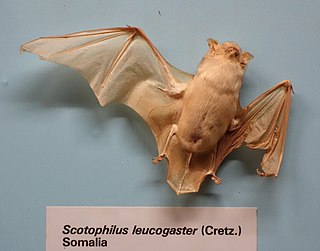
The white-bellied yellow bat or white-bellied house bat, is a species of vesper bat in the genus Scotophilus, the house bats. It can be found in Angola, Benin, Botswana, Burkina Faso, Cameroon, Central African Republic, Chad, Ivory Coast, Gambia, Ghana, Guinea, Guinea-Bissau, Kenya, Mali, Mauritania, Namibia, Niger, Nigeria, Senegal, Sierra Leone, Sudan, Togo, Uganda, and Zambia. It is found in dry and moist savanna and open woodland. It is a common species with a very wide range, and the International Union for Conservation of Nature has assessed its conservation status as being of "least concern".
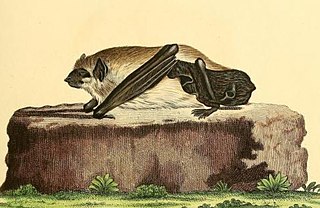
Schreber's yellow bat or the giant house bat, is a species of vesper bat. It is found in Benin, Democratic Republic of the Congo, Ivory Coast, Ghana, Kenya, Malawi, Mozambique, Nigeria, Senegal, Tanzania, Togo, and Zimbabwe. Its natural habitats are subtropical or tropical moist lowland forests, dry savanna, and moist savanna. It is an uncommon species and its biology is poorly known. It was first described in 1774 by the German naturalist Johann Christian Daniel von Schreber, who named it Vespertilio nigrita. It was later transferred to the genus Scotophilus, making it Scotophilus nigrita.
The nut-colored yellow bat is a species of vesper bat. It can be found in Cameroon, Democratic Republic of the Congo, Ivory Coast, Equatorial Guinea, Ghana, Guinea, Kenya, Liberia, Nigeria, Rwanda, Sierra Leone, and Uganda. It is found in subtropical or tropical moist lowland forests.

The greenish yellow bat is a species of vesper bat. It is found in Benin, Botswana, Burkina Faso, Cameroon, Central African Republic, Chad, Ivory Coast, Ethiopia, Gambia, Ghana, Kenya, Madagascar, Malawi, Mali, Mozambique, Namibia, Niger, Nigeria, Senegal, South Africa, Sudan, Tanzania, Togo, Zambia, and Zimbabwe. Its natural habitats are dry and moist savanna.

Buettikofer's epauletted fruit bat is a species of megabat in the family Pteropodidae. It is found in Ivory Coast, Ghana, Guinea, Guinea-Bissau, Liberia, Nigeria, Senegal, and Sierra Leone. Its natural habitats are subtropical or tropical moist lowland forests, dry savanna, and moist savanna. It is threatened by habitat loss.
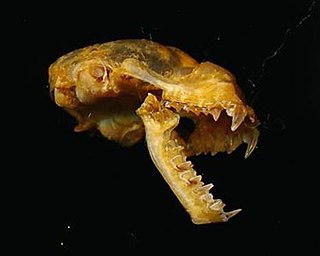
The Benito roundleaf bat is a species of bat in the family Hipposideridae found in Cameroon, Central African Republic, Republic of the Congo, Democratic Republic of the Congo, Ivory Coast, Equatorial Guinea, Gabon, Ghana, Guinea, Liberia, Nigeria, Sierra Leone, South Sudan, and Togo. Its natural habitat is subtropical or tropical moist lowland forests. It is threatened by habitat loss.
Spurrell's free-tailed bat is a species of bat in the family Molossidae named after Herbert George Flaxman Spurrell. It is found in Cameroon, Central African Republic, Ivory Coast, Equatorial Guinea, Ghana, Liberia, Sierra Leone, and Togo. Its natural habitats are subtropical or tropical dry forest and subtropical or tropical moist lowland forest. It is threatened by habitat loss.

The Trevor's free-tailed bat is a species of bat in the family Molossidae. It is found in Central African Republic, Democratic Republic of the Congo, Ivory Coast, Ghana, Guinea, Nigeria, South Sudan, and Uganda. Its natural habitats are subtropical or tropical dry forests and moist savanna. It is threatened by habitat loss.

The Bini free-tailed bat is a species of bat in the family Molossidae. It is found in Cameroon, Central African Republic, Democratic Republic of the Congo, Gabon, Ghana, Nigeria, and Uganda. Its natural habitat is subtropical or tropical moist lowland forests. It is threatened by habitat loss.

The halcyon horseshoe bat is a species of bat in the family Rhinolophidae. It is found in Cameroon, Republic of the Congo, Democratic Republic of the Congo, Ivory Coast, Equatorial Guinea, Ghana, Guinea, Kenya, Liberia, Nigeria, Senegal, South Sudan, Togo, Uganda, possibly Gabon, and possibly Sierra Leone. Its natural habitats are subtropical or tropical dry forest, subtropical or tropical moist lowland forest, moist savanna, caves, and subterranean habitats. It is threatened by habitat loss.
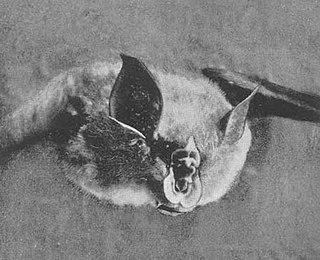
Lander's horseshoe bat is a species of bat in the family Rhinolophidae found in Africa. Its natural habitats are dry savanna, moist savanna, and caves.

Scotophilus is a genus of vespertilionid bats commonly called yellow bats. They are found in southern Asia and Africa.

Andrew Rebori's house bat is a species of bat found in Africa.

Ejeta's house bat is a species of vesper bat found in Ethiopia. It was described as a new species of bat in 2014.

The Marovaza house bat is a species of bat found in Madagascar.

Trujillo's house bat is a species of vesper bat found in Kenya.

The western yellow bat is a species of vesper bat endemic to Madagascar.

















